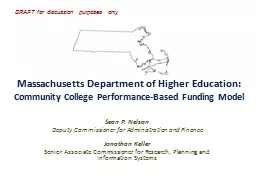PPT-Massachusetts Department of Higher Education:
Author : marina-yarberry | Published Date : 2020-04-08
Community College PerformanceBased Funding Model Sean P Nelson Deputy Commissioner for Administration and Finance Jonathan Keller Senior Associate Commissioner
Presentation Embed Code
Download Presentation
Download Presentation The PPT/PDF document " Massachusetts Department of Higher Educ..." is the property of its rightful owner. Permission is granted to download and print the materials on this website for personal, non-commercial use only, and to display it on your personal computer provided you do not modify the materials and that you retain all copyright notices contained in the materials. By downloading content from our website, you accept the terms of this agreement.
Massachusetts Department of Higher Education: : Transcript
Download Rules Of Document
" Massachusetts Department of Higher Education: "The content belongs to its owner. You may download and print it for personal use, without modification, and keep all copyright notices. By downloading, you agree to these terms.
Related Documents














